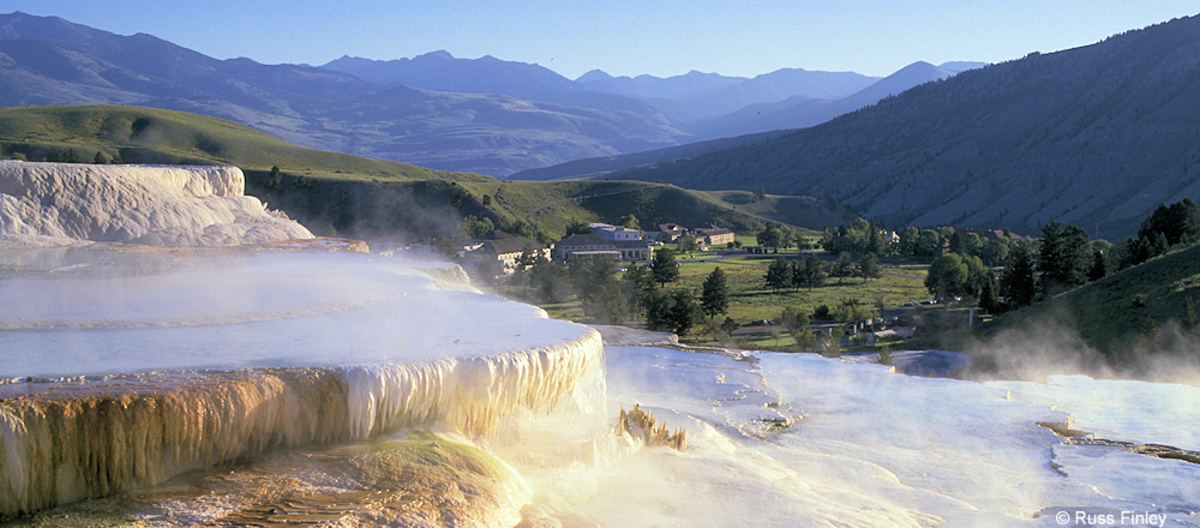Mammoth Hot Springs are the main attraction of the Mammoth District. These features are quite different from thermal areas elsewhere in the park. Travertine formations grow much more rapidly than sinter formations due to the softer nature of limestone. As hot water rises through limestone, large quantities of rock are dissolved by the hot water, and a white chalky mineral is deposited on the surface.
Although visitors are sometimes confused by the rapidly shifting activity of the hot springs and disappointed when a favorite spring appears to have “died,” it is important to realize that the location of springs and the rate of flow changes daily, that “on-again-off-again” is the rule, and that the overall volume of water discharged by all of the springs fluctuates little.
Mammoth Hot Springs are a surficial expression of the deep volcanic forces at work in Yellowstone. Although these springs lie outside the caldera boundary, their energy is attributed to the same magmatic system that fuels other Yellowstone thermal areas. Hot water flows from Norris to Mammoth along a fault line roughly associated with the Norris to Mammoth road. Shallow circulation along this corridor allows Norris’ super-heated water to cool somewhat before surfacing at Mammoth, generally at about 170° F.
Thermal activity here is extensive both over time and distance. Terrace Mountain, northwest of Golden Gate, has a thick cap of travertine. The Mammoth Terraces extend all the way from the hillside where we see them today, across the Parade Ground, and down to Boiling River. The Mammoth Hotel, as well as all of Fort Yellowstone, is built upon an old terrace formation known as Hotel Terrace. There was some concern when construction began in 1891 on the Fort site that the hollow ground would not support the weight of the buildings. Several large sink holes (fenced off) can be seen out on the Parade Ground. This area has been thermally active for several thousand years.
The Mammoth area exhibits much evidence of glacial activity from the Pinedale Glaciation. The summit of Terrace Mountain is covered with glacial till, thereby dating the travertine formation there to earlier than the end of the Pinedale Glaciation. Several thermal kames, including Capitol Hill and Dude Hill, are major features of the Mammoth Village area. Ice-marginal stream beds are in evidence in the small, narrow valleys where Floating Island Lake and Phantom Lake are found. In Gardner Canyon, one can see the old, sorted gravel bed of the Gardner River covered by unsorted glacial till.
Due to its year-round access and comparatively mild winters, Mammoth has always been the headquarters for the park. The hot springs were an early commercialized attraction for those seeking relief from ailments in the mineral waters. Two historic events taking place at Mammoth were the Nez Perce flight in 1877 and President Teddy Roosevelt’s visit in 903.
All of the red-roofed, many-chimneyed buildings in the Mammoth area are part of historic Fort Yellowstone. Beginning in 1886, after 14 years of poor civilian management of the park, the Cavalry was called upon to manage the park’s resources and visitors. Because the Cavalry only expected to be here a short while, they built a temporary post near the base of the Terraces called Camp Sheridan. After five cold, harsh winters, they realized that their stay in the park was going to be longer than expected, so they built Fort Yellowstone, a permanent post.
In 1891, the first building to be constructed was the guard house because it directly coincided with the Cavalry’s mission–protection and management.
There were three stages of construction at Fort Yellowstone. The first set of clapboard buildings were built in 1891, the second set in 1897 as the Fort expanded to a two-troop fort, and, finally, the stone buildings were built in 1909 making the fort’s capacity 400 men or four troops. By 1916, the National Park Service was established, and the Cavalry gave control of Yellowstone back to the civilians. After a short time away, the Cavalry returned in 1917 and finished their duty completely in 1918. Since that time, historic Fort Yellowstone has been Yellowstone’s headquarters.
Mammoth has a Visitor Center. In addition, a number of hiking trails are located in the Mammoth area.
